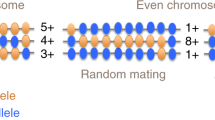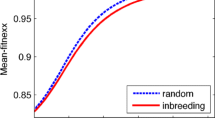Abstract
Phenotypic assortative mating is investigated for a character determined by additive loci without dominance and a stochastically independent environment. Conditional-expectation arguments are used to calculate the equilibrium values of the phenotypic variance and the correlation between sundry relatives. For the latter, it suffices to suppose that the regressions of an individual's genotype on his phenotype and of his phenotype on that of his mate are linear. For the former, linearity of the regression of the allelic effects on the phenotype is also posited. The biological implications of these assumptions are discussed.
Similar content being viewed by others
References
Abramowitz, M.: Elementary analytical methods. In: Abramowitz, M., Stegun, I. A. (eds.): Handbook of mathematical functions, pp. 9–63. Washington: National Bureau of Standards 1964
Bulmer, M. G.: The mathematical theory of quantitative genetics. Oxford: Oxford University Press 1980
Cavalli-Sforza, L. L., Bodmer, W. F.: The genetics of human populations. San Francisco: Freeman 1971
Cloninger, C. R., Rice, J., Reich, T.: Multifactorical inheritance with cultural transmission and assortative mating. II. A general model of combined polygenic and cultural inheritance. Am. J. Hum. Genet. 31, 176–198 (1979)
Crow, J. F., Felsenstein, J.: The effect of assortative mating on the genetic composition of a population. Eugen. Quart. 15, 85–97 (1968)
Denniston, C.: An extension of the probability approach to genetic relationship: One locus. Theoret. Population Biology 6, 58–75 (1974)
Falconer, D. S.: Introduction to quantitative genetics. New York: Ronald Press 1960
Fisher, R. A.: The correlation between relatives on the supposition of Mendelian inheritance. Trans. Roy. Soc. Edinb. 52, 399–433 (1918)
Gimelfarb, A.: Evolving populations: Mathematical analysis of some dynamical properties. Dissertation, University of Wisconsin, Madison, 1979
Gimelfarb, A.: A general linear model for the genotypic covariance between relatives under assortative mating. J. Math. Biol. 13, 209–226 (1981a)
Gimelfarb, A.: Analysis of “nontraditional” relationships under assortative mating. J. Math. Biol. 13, 227–240 (1981b)
Jensen, A. R.: Genetic and behavioral effects of nonrandom mating. In: Nobel, C. E., Osborne, R. T., Weyl, N. (eds.), pp. 51–105. Human variation: Biogenetics of age, race, and sex. New York: Academic Press 1978
Johnson, N. L., Kotz, S.: Distributions in statistics: Discrete distributions. Boston: Houghton Mifflin 1969
Johnson, N. L., Kotz, S.: Distributions in statistics: Continous multivariate distributions. New York: Wiley 1972
Kempthorne, O.: An introduction to genetic statistics. New York: Wiley 1957
Kendall, M. G., Stuart, A.: The advanced theory of statistics, 3rd edition, Vol. 2. London: Griffin 1973
Lande, R.: The influence of the mating system on the maintenance of genetic variability in polygenic characters. Genetics 86, 485–498 (1977)
Lande, R.: The minimum number of genes contributing to quantitative variation between and within populations. Genetics 99, 541–553 (1981)
Lukacs, E.: Characteristic functions, 2nd edition. London: Griffin 1970
Malécot, G.: Théorie mathématique de l'hérédité mendelienne généralisée. Paris: Guilhot 1939; Reprinted in Malécot, G.: Probabilités et hérédité. Paris: Presses Universitaires de France 1966
Moran, P. A. P., Smith, C. A. B.: Commentary on R. A. Fisher's paper on “The correlation between relatives on the supposition of Mendelian inheritance.” Eugen. Lab. Mem. 46, 1966
Nagylaki, T.: Selection in one- and two-locus systems. Berlin: Springer 1977
Nagylaki, T.: The correlation between relatives with assortative mating. Ann. Hum. Genet. 42, 131–137 (1978)
Risch, H.: The correlation between relatives under assortative mating for an X-linked and autosomal trait. Ann. Hum. Genet. 43, 151–165 (1979)
Spuhler, J. N.: Assortative mating with respect to physical characteristics. Eugen. Quart. 15, 128–140 (1968)
Vandenberg, S. G.: Assortative mating, or who marries whom? Behav. Genet. 2, 127–157 (1972)
Wilson, S. R.: The correlation between relatives under the multifactorial model with assortative mating. Ann. Hum. Genet. 37, 189–204, 205–215 (1973)
Wright, S.: Systems of mating. III. Assortative mating based on somatic resemblance. Genetics 6, 144–161 (1921)
Wright, S.: Evolution and the genetics of populations. Vol. II. Chicago: The University of Chicago Press 1969
Wright, S.: Evolution and the genetics of populations. Vol. IV. Chicago: The University of Chicago Press 1978
Author information
Authors and Affiliations
Additional information
Supported by National Science Foundation Grant DEB81-03530
Rights and permissions
About this article
Cite this article
Nagylaki, T. Assortative mating for a quantitative character. J. Math. Biology 16, 57–74 (1982). https://doi.org/10.1007/BF00275161
Revised:
Issue Date:
DOI: https://doi.org/10.1007/BF00275161




